CRI实用英语课堂 Unit 26 Environmental Protection III 环境保护(下)
搜索关注在线英语听力室公众号:tingroom,领取免费英语资料大礼包。
(单词翻译)
Part 6 Noise Pollution 噪音污染
Noise is among the most pervasive1 pollutants2 today. Noise from road traffic, jet planes, jet skis, garbage trucks, construction equipment, manufacturing processes, lawn mowers, leaf blowers, and boom boxes, to name a few, are among the audible litter that are routinely broadcast into the air.
traffic, jet planes, jet skis, garbage trucks, construction equipment, manufacturing processes, lawn mowers, leaf blowers, and boom boxes, to name a few, are among the audible litter that are routinely broadcast into the air.
Noise negatively affects human health and well-being3. Problems related to noise include hearing loss, stress, high blood pressure, sleep loss, distraction4 and lost productivity, and a general reduction in the quality of life and opportunities for tranquillity5.
We experience noise in a number of ways. On some occasions, we can be both the cause and the victim of noise, such as when we are operating noisy appliances or equipment. There are also instances when we experience noise generated by others just as people experience second-hand6 smoke. While in both instances, noises are equally damaging, second-hand noise is more troubling because it has negative impacts on us but is put into the environment by others, without our consent.
Noise pollution is not easily defined. Part of the difficulty lies in the fact that in some ways it is different from other forms of pollution. Noise is transient; once the pollution stops, the environment is free of it. This is not the case for chemicals, sewage, and other pollutants introduced into the air, soil, or water.
The definition of noise itself is highly subjective7. To some people the roar of an engine is satisfying or thrilling; to others it is an annoyance8. Loud music may be enjoyable or a torment9, depending on the listener and the circumstances. Broadly speaking, any form of unwelcome sound is noise pollution, whether it is the roar of a jet plane overhead or the sound of a barking dog a block away.
The actual loudness of a sound is only one component10 of the effect it has on human beings. Other factors that have to be considered are the time and place, the duration, the source of the sound, and whether the listener has any control over it. Most people would not be bothered by the sound of a 21-gun salute11 on a special occasion. On the other hand, the thump-thump of a neighbour's music at 2 a.m., even if barely audible, could be a major source of stress.
The decibel12 (dB) (分贝) is a measure of sound intensity13; that is, the magnitude of the fluctuations14 in air pressure caused by sound waves. In fact, an increase of just 3 dB means twice as much sound, and an increase of 10 dB means ten times as much sound.
A sound pressure level of 0 dB represents the threshold of hearing in the most sensitive frequency range of a young, healthy ear, while the thresholds of tickling15 or painful sensations in the ear occur at about 120 to 130 dB. There is fairly consistent evidence that prolonged exposure to noise levels at or above 80 dB can cause deafness. The amount of deafness depends upon the degree of exposure.
Noise can cause annoyance and frustration16 as a result of interference, interruption and distraction. Exposure to noise is also associated with a range of possible physical effects including: colds, changes in blood pressure, other cardiovascular changes, increased general medical practice attendance, problems with the digestive system and general fatigue17.
通常所说的噪声污染是指人为活动而不是自然现象引起的。噪声污染是物理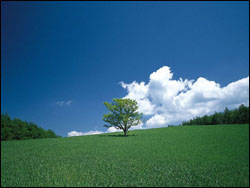 性污染,本身对人无害,只是在环境中的流量过高或过低时,才会造成污染或异常。物理性污染一般是局部性的,即一个噪声源不会影响很大的区域。
性污染,本身对人无害,只是在环境中的流量过高或过低时,才会造成污染或异常。物理性污染一般是局部性的,即一个噪声源不会影响很大的区域。
另处,物理性污染没有后效作用,即噪声不会残存在环境中,噪声停止,污染立即消失。外界噪音污染主要来自航空、公路、铁路运输,以及工程施工和工业生产等;而室内噪音污染则来自风扇、电脑及其它家用电器。
噪音污染不但能够影响人的听力,而且能够导致高血压、心脏病、记忆力衰退、注意力不集中及其它精神综合征。研究表明,人听觉最高可以接受30分贝的音量,当室内的持续噪音污染超过30分贝时,人的正常睡眠就会受到干扰,而持续生活在70分贝以上的噪音环境中,人的听力及身体健康将会受到影响。
世界卫生组织(WHO)最近就全世界的噪音污染情况进行了分析调查,认为全球噪音污染已经成为影响人们身体健康和生活质量的严重问题,呼吁世界各国积极采取有效措施来控制减少噪音污染。
为此,他们建议各国政府将治理噪音污染纳入国家的环保计划,将卫生组织的指导性标准视为噪音治理的长期目标,制定和实施有关噪音管理的法律法规,支持有关减少噪音的科学研究,
制定和完善有关噪音的测量标准,鼓励有关噪音对环境和健康影响的研究,进一步加强有关噪音污染的宣传,让全社会重视噪音污染的危害,减少噪音污染对人类健康的影响。
Dialogue Script 对话原文
Sarah: I can't bear the noise near my house any more! 
Tim: Why? Is it that bad?
Sarah: The road near my house has been mended for more then half a year, and it is still not completed.
Tim: Is the noise very loud?
Sarah: Absolutely! I'm nearly becoming deaf if the situation won't be changed in a few days, I'm afraid.
Tim: It's really terrible, but you can prosecute18 them for doing harm to the residence nearby.
Sarah: That's right! But I haven't got so much time and money.
Tim: Do the other people from your neighborhood complain about it?
Sarah: Yes, most of them do.
Tim: Why not hold a meeting? I'm sure you can come up with some solutions.
讲解:
1. 对话中Sarah和Tim在讨论她家附近噪音污染的问题。Sarah抱怨说她再也忍受不了家附近的噪音了。这里bear做动词表示“忍受,承受”,也可以用stand替换。例如:I can't bear his complaining.我无法忍受他总是抱怨。那么短语bear with someone就表示“容忍,耐心忍受某人”,例如:Bear with me while I explain it.请耐心听我的解释。
2. Tim很关心地问,is it that bad?有那么糟糕吗?这里的that修饰bad,这也是口语当中很常见的现象,表示“那么,那样”,The problem is not that complicated. 这个问题没有那么复杂。和that相对的this也可以这么用,就表示“这么,这样”,例如:I never stayed out this late.我从来没在外面待到这么晚。
3. Sarah家附近为什么会有噪音呢?原来她家旁边的那条路已经修了大半年了,到现在也没有修好,整天机器轰鸣,不吵才怪。再这样下去,耳朵都要震聋了。
4. 真是太糟糕了。Tim建议Sarah可以起诉他们干扰了附近居民的正常生活。prosecute是一个法律术语,表示“对…提起公诉,对…提起 民法或刑法诉讼行为”。更口语化一点的词呢是sue,像我昨天看的电影里就有一句台词是Sue me if you want. 意思就是“想告我就尽管去”。
民法或刑法诉讼行为”。更口语化一点的词呢是sue,像我昨天看的电影里就有一句台词是Sue me if you want. 意思就是“想告我就尽管去”。
5. Sarah也觉得这是一个好主意,但是她怕耗不起那些钱和精力。的确,如果想起诉的话,就要陪上很多金钱和精力,这对一个普通的人来说并不是一件容易的事情。Tim问Sarah她的邻居们是否也有这样的抱怨。complain about这个词组表示“抱怨,埋怨”,例如:Jenny is always complaining about something. Jenny总是满腹牢骚。They complained about the food. 他们抱怨这糟糕的食物。
6. complain后面还可以加that从句,例如:They complained that the wages were far too low. 他们抱怨说工资太低了。Sarah的邻居们也都在抱怨这件事情,Tim就建议他们召集居民会议,看看能不能想出什么解决办法。come up with something表示“想出,提出某事”,例如:He came up with a new idea for increasing sales. 他想出了一个增加销售量的新办法。
Part 7 Global Warming 全球暖化
According to the National Academy of Sciences, the Earth's surface temperature has risen by about 1 degree Fahrenheit19 in the past century, with accelerated warming during the past two decades. There is new and stronger evidence that most of the warming over the last 50 years is attributable to human ac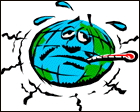 tivities.
tivities.
Human activities have altered the chemical composition of the atmosphere through the buildup of greenhouse gases – primarily carbon dioxide, methane21, and nitrous oxide20. The heat-trapping property of these gases is undisputed although uncertainties22 exist about exactly how earth’s climate responds to them.
Energy from the sun drives the earth's weather and climate, and heats the earth's surface; in turn, the earth radiates energy back into space. Atmospheric23 greenhouse gases, such as water vapor24, carbon dioxide, trap some of the outgoing energy, retaining heat somewhat like the glass panels of a greenhouse.
Without this natural "greenhouse effect," temperatures would be much lower than they are now, and life as known today would not be possible. Instead, thanks to greenhouse gases, the earth's average temperature is a more hospitable25 60°F.
However, problems may arise when the atmospheric concentration of greenhouse gases increases. Once, all climate changes occurred naturally. However, during the Industrial Revolution, we began altering our climate and environment through changing agricultural and industrial practices.
Before the Industrial Revolution, human activity released very few gases into the atmosphere, but now through population growth, fossil fuel burning, and deforestation, we are affecting the mixture of gases in the atmosphere. 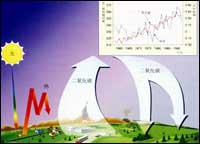
Carbon dioxide is released to the atmosphere when solid waste, fossil fuel and wood products are burned. Methane is emitted during the production and transport of coal, natural gas, and oil. Methane emissions26 also result from the decomposition27 of organic wastes in municipal solid waste landfills, and the raising of livestock28. Nitrous oxide is emitted during agricultural and industrial activities, as well as during combustion29 of solid waste and fossil fuels.
Rising global temperatures are expected to raise sea level, and change precipitation and other local climate conditions. Changing regional climate could alter forests, crop yields, and water supplies. It could also affect human health, animals, and many types of ecosystems30 and deserts may expand into existing rangelands. Unless we act now, our children will inherit a hotter world, dirtier air and water, more severe floods and droughts, and more wildfires.
But solutions are in sight. We know where most heat-trapping gases come from: power plants and vehicles. And we know how to curb31 their emissions: modern technologies and stronger laws. By shifting the perception of global warming from abstract threat to pressing reality, and promoting online activism. By pressing businesses to use less energy and build more efficient products. And by fighting for laws that will speed these advances.
“温室效应”是指地球大气层上的一种物理特性。假若没有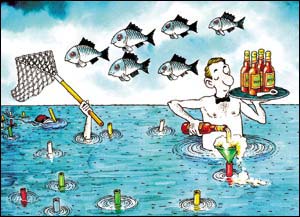 大气层,地球表面的平均温度不会是现在合宜的15℃,而是十分低的-18℃。这种温度上的差别是由温室气体导致的,这些气体吸收红外线辐射而影响到地球整体的能量平衡。受到温室气体的 影响,大气层吸收红外线辐射的份量比它释放到太空外的垛,这使地球表面温度上升,这个过程就是“天然的温室效应”。但由于人类活动释放出大量的温室气体,结果让更多红外线辐射被折射到地面上,加强了“温室效应”的作用。
大气层,地球表面的平均温度不会是现在合宜的15℃,而是十分低的-18℃。这种温度上的差别是由温室气体导致的,这些气体吸收红外线辐射而影响到地球整体的能量平衡。受到温室气体的 影响,大气层吸收红外线辐射的份量比它释放到太空外的垛,这使地球表面温度上升,这个过程就是“天然的温室效应”。但由于人类活动释放出大量的温室气体,结果让更多红外线辐射被折射到地面上,加强了“温室效应”的作用。
全球变暖是目前全球环境研究的一个主要议题。根据对100多份全球温度变化资料的系统分析,发现全球平均温度已升高0.3~0.6摄氏度。其中11个最暖的年份发生在80年代中期以后,因而全球变暖是一个毋庸置疑的事实。全球变暖将带来非常严重的后果,如冰川消退、海平面上升、荒漠化等等,还给生态系统、农业生产带来严重影响。全球变暖现象最终可能会导致全球变冷,形成另一次冰河时代。就像我们在美国电影《后天》里面看到的可怕情景。
因此,探求全球变暖的起因成为重要的研究课题。分析表明,虽然地球演化史上曾经多次发生变暖--变冷的气候波动,但人类活动引起的大气温室效应增长可能是主要因素。
各国政府、企业和科学家们逐步达成共识,大家必须迅速行动起来,与气候变化作斗争。目前人们已经采取措施限制二氧化碳的排放量。许多公司正积极应对二氧化碳限排时代的到来。
Part 8 El Nino and La Nina 厄尔尼诺和拉妮娜
El Nino and La Nina are opposite phases of the El Nino-Southern Oscillation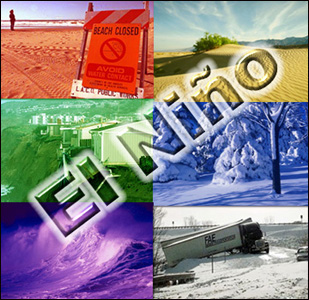 (ENSO) cycle, with La Nina sometimes referred to as the cold phase of ENSO and El Nino as the warm phase of ENSO.
(ENSO) cycle, with La Nina sometimes referred to as the cold phase of ENSO and El Nino as the warm phase of ENSO.
El Nino is a disruption of the ocean-atmosphere system in the tropical Pacific having important consequences for weather around the globe. Among these consequences are increased rainfall across the southern tier of the US and in Peru, which has caused destructive flooding, and drought in the West Pacific, sometimes associated with devastating32 brush fires in Australia.
In normal, non-El Nino conditions, the trade winds blow towards the west across the tropical Pacific. These winds pile up warm surface water in the west Pacific, so that the sea surface is about 1/2 meter higher at Indonesia than at Ecuador.
The sea surface temperature is about 8 degrees C higher in the west, with cool temperatures off South America, due to an upwelling of cold water from deeper levels. This cold water is nutrient33-rich, supporting high levels of primary productivity, diverse marine34 ecosystems, and major fisheries. Rainfall is found in rising air over the warmest water, and the east Pacific is relatively35 dry.
During El Nino, the trade winds relax in the central and western Pacific leading to a depression of the thermocline in the eastern Pacific, and an elevation36 of the thermocline in the west. This reduced the efficiency of upwelling to cool the suface and cut off the supply of nutrient rich thermocline water to the euphotic zone. The result was a rise in sea surface temperature and a drastic decline in primary productivity, the latter of which adversely37 affected38 higher trophic levels of the food chain, including commercial fisheries in this region.
Rainfall follows the warm water eastward39, with associated flooding in Peru and drought in Indonesia and Australia. The eastward displacement40 of the atmospheric heat source overlaying the warmest water results in large changes in the global atmospheric circulation, which in turn force changes in weather in regions far removed from the tropical Pacific.
Global climate La Nina impacts tend to be opposite those of El Ninno impacts. In the tropics, ocean temperature variations in La Nina tend to be opposite those of El Nino. At higher latitudes41, El Nino and La Nina are among a number of factors that influence climate. However, the impacts of El Nino and La Nina at these latitudes are most clearly seen in wintertime.
In the continental42 US, during El Nino years, temperatures in the winter are warmer than normal in the North Central States, and cooler than normal in the Southeast and the Southwest. During a La Nina year, winter temperatures are warmer than normal in the Southeast and cooler than no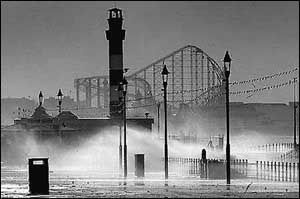 rmal in the Northwest.
rmal in the Northwest.
The twists and turns in the ongoing43 dialogue between ocean and atmosphere in the Pacific can have a ripple44 effect on climatic conditions in far flung regions of the globe. This worldwide message is conveyed by shifts in tropical rainfall, which affect wind patterns over much of the globe.
Imagine a rushing stream flowing over and around a series of large boulders45. The boulders create a train of waves that extend downstream, with crests46 and troughs that show up in fixed47 positions. If one of the boulders were to shift, the shape of the wave train would also change and the crests and troughs might occur in different places.
Dense48 tropical rainclouds distort the air flow aloft 5-10 miles above sea level much as rocks distort the flow of a stream, or islands distort the winds that blow over them, but on a horizontal scale of thousands of miles. The waves in the air flow, in turn, determine the positions of the monsoons49, and the storm tracks and belts of strong winds aloft, commonly referred to as jet streams, which separate warm and cold regions at the Earth's surface.
In El Nino years, when the rain area that is usually centered over Indonesia and the far western Pacific moves eastward into the central Pacific, as shown on p. 17, the waves in the flow aloft are affected, causing unseasonable weather over many regions of the globe.
近年来,各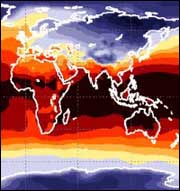 类媒体越来越关注这样一个气候学名词:厄尔尼诺。众多气候现象与灾难都被归结到厄尔尼诺的肆虐上,例如印尼的森林大火、巴西的暴雨、 北美的洪水及暴雪、非洲的干旱等等。它几乎成了灾难的代名词!
类媒体越来越关注这样一个气候学名词:厄尔尼诺。众多气候现象与灾难都被归结到厄尔尼诺的肆虐上,例如印尼的森林大火、巴西的暴雨、 北美的洪水及暴雪、非洲的干旱等等。它几乎成了灾难的代名词!
可是厄尔尼诺究竟是什么呢?用一句话来说:厄尔尼诺是热带大气和海洋相互作用的产物,它原是指赤道海面的一种异常增温,现在其定义为在全球范围内,海气相互作用下造成的气候异常。
厄尔尼诺现象是发生在大气环流和海洋环流之间的强耦合事件的例子。大气环流(风)施加于海洋的应力是海洋环流的主要驱动力,同时,正如我们所看到的那样,来自海洋的热量,特别是蒸发作用对大气环流有极大的影响。
厄尔尼诺现象的基本特征是赤道太平洋中东海域海水温度异常增高。由于热带太平洋是一个控制大气运动的巨大热源和水气源,因此厄尔尼诺现象的发生将引起全球气候异常。
拉尼娜是指赤道太平洋东部和中部海面温度持续异常偏冷的现象(与厄尔尼诺现象正好相反)。是气象和海洋界使用的一个新名词。意为“小女孩”,正好与意为“圣婴”的厄尔尼诺相反,也称为“反厄尔尼诺”或“冷事件”。
厄尔尼诺与赤道中、东太平洋海温的增暖、信风的减弱相联系,而拉尼娜却与赤道中、东太平洋海温度变冷、信风的增强相关联。因此,实际上拉尼娜是热带海洋和大气共同作用的产物。
拉尼娜同样对气候有影响。拉尼娜与厄尔尼诺性格相反,随着厄尔尼诺的消失,拉尼娜的到来,全球许多地区的天气与气候灾害也将发生转变。总体说来,拉尼娜并非性情十分温和,它也将可能给全球许多地区带来灾害,其气候影响与厄尔尼诺大致相反,但其强度和影响程度不如厄尔尼诺。
Global environmental collapse50 is not inevitable51. But the developed world must work with the developing world to ensure that new industrialized economies do not add to the world's environmental problems. Politicians must th ink of sustainable development rather than economic expansion.
ink of sustainable development rather than economic expansion.
Conservation strategies have to become more widely accepted, and people must learn that energy use can be dramatically diminished without sacrificing comfort. In short, with the technology that currently exists, the years of global environmental mistreatment can begin to be reversed.
科学技术以前所未有的速度和规模迅猛发展,增强了人类改造自然的能力,给人类社会带来空前的繁荣,也为今后的进一步发展准备了必要的物质技术条件。对此,人们产生了盲目乐观情绪,好象自己已经成为大自然的主人,可以长期掠夺资源而不会受到大自然的惩罚。然而,这种掠夺式生产已经造成了生态和生活的破坏,大自然向人类亮起了红灯。
人们承认面临的严重危机,但是可以通过共同的努力战胜它,寻求新的发展道路。可持续发展战略的核心是经济发展与保护资源、保护生态环境的协调一致,让人类子孙后代能够享有充分的资源和良好的自然环境。可持续发展是一个长期的战略目标,需要人类世世代代的共同奋斗。现在是从传统增长到可持续发展的转变时期,因而最近几代人的努力是成功的关键。
 收听单词发音
收听单词发音 




